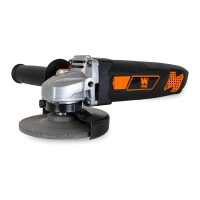9
MAINTENANCE
TO PREVENT SERIOUS INJURY FROM ACCIDENTAL OPERATION:
Make sure that the trigger is in the OFF position and unplug the tool from its electrical outlet before
performing any procedure in this section.
TO PREVENT SERIOUS INJURY FROM TOOL FAILURE:
Do not use damaged equipment. If abnormal noise or vibration occurs, have the problem corrected
before further use.
BEFORE EACH USE, inspect the general condition of the tool. Check for:
• loose hardware,
• misalignment or binding of moving parts,
• damaged cord/electrical wiring,
• cracked or broken parts, and
• any other condition that may affect its safe operation.
AFTER USE, wipe external surfaces of the tool with clean cloth.
WARNING! If the supply cord of this power tool is damaged, it must be replaced only by a qualied
service technician.
OPERATION
SELECTING THE GRINDING DISC
Before using a grinding wheel, make sure that its maximum safe operating speed is
more than 11,000 RPM. Do not exceed the recommended wheel diameter. Make
sure it has a 7/8 inch arbor size to fit the supplied inner flange.
Grinding wheels should be carefully selected in order to maximize efficiency.
Wheels vary in abrasiveness, bond, harness, grit size and structure. The correct
type of wheel to use is determined by the job at hand. Use disc grinding wheels for
fast grinding of structural steel, heavy weld beads, steel casting, stainless steel and
other ferrous metals.
GRINDING TIPS
Efficient grinding is achieved by controlling the pressure and keeping the angle be-
tween the wheel and the workpiece between 15° to 30°. If the wheel is flat, the tool
will be difficult to control. If the angle is too steep, the pressure concentrated on a
small area can cause burning to the work surface.
WARNING - excessive or sudden pressure on the wheel will slow the grinding action and put dangerous stresses
on the wheel.
When grinding with a new wheel, be sure to grind while pulling the tool backwards until the wheel becomes
rounded on its edge. New wheels have sharp corners which tend to “bite” or cut into the workpiece when pushing
forward.
Fig. E
1

